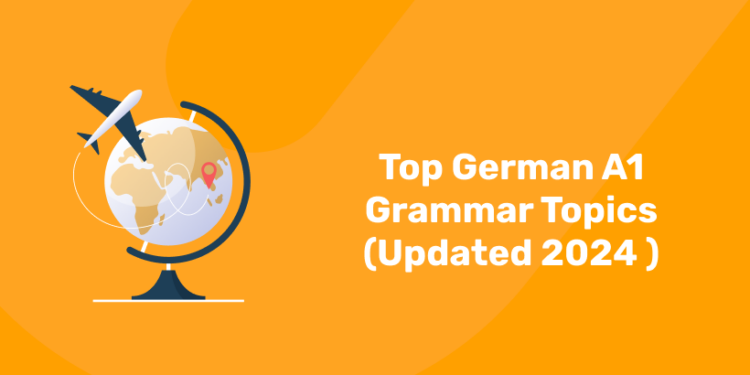Table of Contents
According to Common European Framework of Reference for Languages (CEFR), A1 is the first level of proficiency in the six-tiered system. This is the level where one acquires basic skills in the German language. At this level, you will be able to handle simple everyday situations and routine tasks. In this article, we will look at German A1 grammar topics.
Click here to join the Entri online German language course! Watch demo classes here!
What is German A1?
German A1 is the basic level where you will be able to understand simple German sentences and basic words that describe yourself and the things around you. You will be able to introduce yourself, write simple things like filling a form, and use simple greetings. At this level, you will understand dates, time and numbers. You will also be able to ask or give directions and place orders.
German A1 Grammar Topics
1: How do you say "Good Morning" in German?
As this is the introductory level, the emphasis is on laying the foundation for the language. In German A1 level, you will learn the fundamental grammar concepts. The German A1 grammar topics are:
Gender
Every German noun has a grammatical gender and they start with a capital letter. There are three genders in German language:
- masculine – der
- feminine – die
- neuter – das
Although you have to memorize these genders, there are some hints that can help make things easier.
- If the noun ends in -er, -en, -ig, –ling, -us, -mus, -or it is masculine. Example: der Honig (honey), der Kön_ig_ (king)
- If it ends in -in, -ion, -ung, -heit, -keit, -schaft, -ei, -ur, -ik, -tät, -anz, -enz, -ie, it is feminine. Example: die Eins (one), die Oma (grandma)
- If the noun ending is -tum, -chen, -lein, -ment, -um, it is neuter. Example: das Museum, das Essen (food)
Definite Articles (der, die, das)
The definite articles in German are: der, die and das. It is similar to ‘the’ in English. The definite article depends on the gender and number of the noun.
- masculine – der
- feminine – die
- neuter – das
- plural – die
Example: der Hund (the dog), die Katze (the cat), das Kaninchen (the rabbit), die Hund_e_ (the dogs), die Katze_n_ (the cats).
Note: The definite article ‘die’ is used for plural noun (even if the noun is masculine or neuter).
Indefinite articles (ein, eine)
The indefinite articles in German are: ein and eine. It is similar to ‘a’ and ‘an’ in English.
- masculine – ein
- feminine – die
- neuter – ein
Examples: ein Hund (a dog), eine Katze (a cat), ein Kaninchen (a rabbit)
Note: There is no indefinite article for plural noun.
Singular and Plural
In German, the plural nouns are formed by adding -n/-en, -e, -r/-er, -s. Some nouns are the same in both their singular and plural forms. The ending of the nouns help us understand as to which plural ending to use. Let us have a look at the rules.
We add -n or -en to the following:
- masculine nouns with the endings -e, -ent, and, -ant, -ist, -or
- Example: der Student – die Studenten
- feminine nouns with the endings -e, -in, -ion, -ik, -heit, -keit, -schaft, -tät, -ung
- Example: die Nation – die Nationen
- the endings -ma, -um, -us in foreign words are replaced by -en
- Example: das Thema – die Themen
We add -e to the following noun:
- masculine nouns with the endings -eur, -ich, -ier, -ig, -ling, -ör
- Example: der Friseur – die Friseure
- many single-syllable feminine nouns
- Example: die Hand – die Hände
- We add -r/ -er to the following:
- many single-syllable neuter nouns
- Example: das Wort – die Wörter
We add -s to the following:
- masculine, feminine, and neuter nouns with the endings -a, -i, -o, -u, -y
- Example: das Hobby – die Hobbys
- family names
- Example: die Lehmanns
Personal Pronouns
The personal pronouns in German are ich, du, er, sie, es, wir, ihr, sie and their declined forms. These pronouns have different forms depending on the case. The different types of personal pronoun are:
- Nominative personal pronouns. Example: Ich habe einen Sohn (I have a son)
- Accusative personal pronouns. Example: fang ihn! (Catch him)
- Dative personal pronouns. Example: Ich sage ihnen Bescheid (I’ll let them know)
Basic Sentence Structure
An independent clause includes a subject, a verb, and an object. They are in the order subject + verb + object. Unlike English, in German we can change the order of sentences to emphasize different things.
Example:
Der Hund fängt den Ball.
Den Ball fängt der Hund.
Both these sentences mean that ‘The dog catches the ball’. Here the order of the sentence is changed, but it does not change the meaning of the sentence.
Present Tense Verb Conjugation
The present tense, called (Präsens), is used to talk about the present and future. It is the most commonly used tense in the German language. In German, the present tense is used to express both a simple action and a continuous action.
You need to learn how to conjugate these verbs. To conjugate verbs in the present tense, we remove the infinitive ending -en and add personal endings like -e, -(e)st, (e)t, –en, -(e)t, –en.
Example: ich koche (I cook)
Learn the basics to advance of German with the help of Entri app. The comprehensive German language course prepares you to read, write and converse in German.
You get access to live and recorded classes with experienced and certified faculties. You also get Goethe exam assistance and pre Goethe mock test. We also provide personalized feedback and in-app assistance which helps students to identify their strengths and weaknesses.
The salient features of our German course are:
- Live interactive classes
- Recorded classes after live sessions
- PDF notes and assignments
- Local language tutor
- Goethe Test assistance and mock test
| German Language Courses | |
| German A1 Course Online | German Language A2 Course |
| German B1 Course Online | Online German B2 Course |
Frequently Asked Questions
Is German A1 level difficult?
German A1 is the basic level and hence it is very easy.
What are the modules in German A1 exam?
The four modules in German A1 exam are reading, writing, listening and speaking.
What is the pass mark for German A1 exam?
You should score 60%, that is 36 points.










